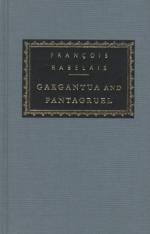Chapter 4.L.
How Homenas showed us the archetype, or representation of a pope.
Mass being mumbled over, Homenas took a huge bundle of keys out of a trunk near the head altar, and put thirty-two of them into so many keyholes; put back so many springs; then with fourteen more mastered so many padlocks, and at last opened an iron window strongly barred above the said altar. This being done, in token of great mystery he covered himself with wet sackcloth, and drawing a curtain of crimson satin, showed us an image daubed over, coarsely enough, to my thinking; then he touched it with a pretty long stick, and made us all kiss the part of the stick that had touched the image. After this he said unto us, What think you of this image? It is the likeness of a pope, answered Pantagruel; I know it by the triple crown, his furred amice, his rochet, and his slipper. You are in the right, said Homenas; it is the idea of that same good god on earth whose coming we devoutly await, and whom we hope one day to see in this country. O happy, wished-for, and much-expected day! and happy, most happy you, whose propitious stars have so favoured you as to let you see the living and real face of this good god on earth! by the single sight of whose picture we obtain full remission of all the sins which we remember that we have committed, as also a third part and eighteen quarantaines of the sins which we have forgot; and indeed we only see it on high annual holidays.
This caused Pantagruel to say that it was a work like those which Daedalus used to make, since, though it were deformed and ill drawn, nevertheless some divine energy, in point of pardons, lay hid and concealed in it. Thus, said Friar John, at Seuille, the rascally beggars being one evening on a solemn holiday at supper in the spital, one bragged of having got six blancs, or twopence halfpenny; another eight liards, or twopence; a third, seven caroluses, or sixpence;




